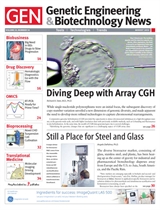Sep 9 2013
Biogen Idec and Isis Pharmaceuticals said today they inked their fourth collaboration in the past two years - a six-year, up-to-$320 million-plus partnership designed to develop new therapies for neurological diseases by applying the former's neurology expertise and the latter's antisense technology.
Biogen Idec agreed to pay Isis $100 million up front, most of which the company will account toward R&D expenses in its third quarter financial results. Isis will also receive payments tied to undisclosed milestones, plus license fees and royalty payments, for all treatments developed through the collaboration. The size of payment will depend on the type of molecule advanced by Biogen Idec. Milestone payments could be as much as $220 million for antisense molecules, the companies said.
Isis will be primarily responsible for drug discovery and early development of antisense therapies, while Biogen Idec will be responsible for creating and developing small molecule treatments and biologics. Biogen Idec will determine the molecular modality best suited for advancement through clinical development, then take responsibility for later stage development and commercialization of all drugs produced through the collaboration.
"Antisense is a validated technology that we believe will help build our pipeline of antisense, small molecule, and biologics programs, strengthening our leadership in neurology," Douglas E. Williams, Ph.D., Biogen Idec's evp of R&D, said in a statement.
Biogen Idec and Isis established their first collaboration in January 2012, an up-to-$299 million deal to develop Isis' antisense drug candidate developed with Isis for Spinal Muscular Atrophy (SMA). ISIS-SMNRX is now in Phase II trials, and enjoys orphan-drug designation with fast-track status granted by the FDA.
In that deal, Isis received $29 million upfront, and could see up to $45 million tied to milestones associated with clinical development of ISIS-SMNRx before licensing. That could rise, up to another $225 million from a license fee and more milestone payments, plus double-digit royalties, if Biogen Idec exercises an option to license the treatment until completion of the first successful Phase II/III trial, thus assuming global development, regulatory, and commercialization responsibilities. Otherwise, Isis is responsible for global development of ISIS-SMNRx through completion of Phase II/III, with Biogen Idec providing advice on clinical trial design and regulatory strategy.
The second collaboration, announced in June 2012, had Biogen Idec and Isis agreeing to develop and commercialize a new antisense drug for myotonic dystrophy type 1 (DM1) or Steinert disease. Biogen Idec agreed to pay Isis $12 million up front for discovering a DM1 treatment that would target DMPK, plus up to $59 million in milestone payments before licensing, then up to another $200 million in a license fee and regulatory milestone payments if Biogen Idec used its option to license the drug from Isis up through completion of a Phase II trial. Isis would also receive double-digit royalties.
In December 2012, Isis and Biogen Idec entered into a third collaboration of up to $630 million to discover and develop antisense drugs against three new undisclosed targets to treat neurological or neuromuscular disorders. Isis received $30 million up front, with up to $200 million in license fees and payments for undisclosed regulatory milestones per program.

 This article was reprinted from Genetic Engineering & Biotechnology News (GEN) with permission from Mary Ann Liebert, Inc., publishers. Genetic Engineering & Biotechnology News (GEN) has retained its position as the number one biotech publisher around the globe since its launch in 1981. GEN publishes a print edition 21 times a year and has additional exclusive editorial content online, like news and analysis as well as blogs, podcasts, webinars, polls, videos, and application notes. GEN's unique news and technology focus includes the entire bioproduct life cycle from early-stage R&D, to applied research including omics, biomarkers, as well as diagnostics, to bioprocessing and commercialization.
This article was reprinted from Genetic Engineering & Biotechnology News (GEN) with permission from Mary Ann Liebert, Inc., publishers. Genetic Engineering & Biotechnology News (GEN) has retained its position as the number one biotech publisher around the globe since its launch in 1981. GEN publishes a print edition 21 times a year and has additional exclusive editorial content online, like news and analysis as well as blogs, podcasts, webinars, polls, videos, and application notes. GEN's unique news and technology focus includes the entire bioproduct life cycle from early-stage R&D, to applied research including omics, biomarkers, as well as diagnostics, to bioprocessing and commercialization.